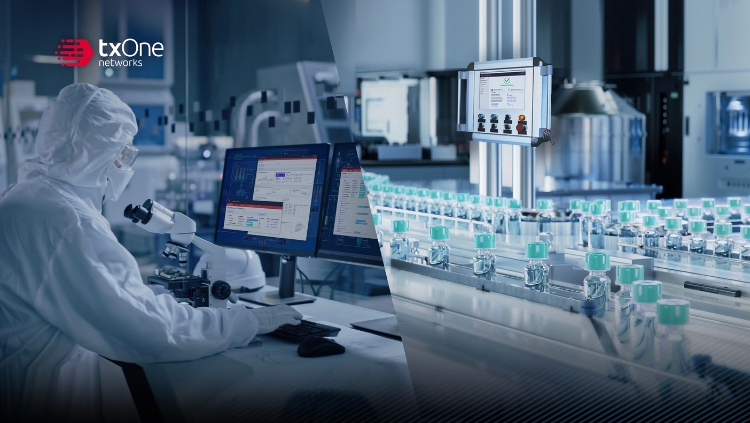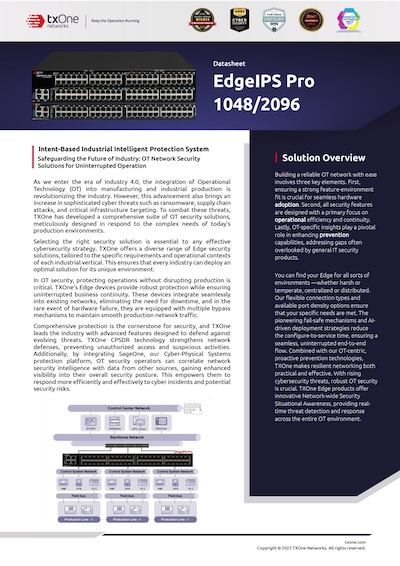Companies in the food industry are seen as some of the most vulnerable potential victims of cyberattacks. This is due to a combination of legacy systems and modern technology being used throughout the supply chain, along with an absence of robust, industry-wide cybersecurity practices.
In many cases, investment into cybersecurity measures is hard to justify when there’s no active return or profit for the bottom line. The interconnected nature of the food supply chain also makes it harder to implement any cybersecurity systems and might cause companies to think it’s too big of a hassle.
However, many companies fail to consider the costs of leaving themselves open and vulnerable to cyberattacks. Companies can lose millions if compromised, and the direct and indirect costs can pile up. This article will discuss the financial and reputational impacts that a cyberattack can have on the food and beverage manufacturing industry.
Cybersecurity Threats in the Food Manufacturing Industry
Food manufacturing supply chains are complex networks, with many different suppliers. This can be a security risk if not managed properly.
A lot of food companies use a mix of old and new tech. They might have the latest internet-connected machines on the factory floor, but still use outdated computer systems in other areas. If these systems aren’t separated correctly, hackers could find a weakness in the old system and use it to access the newer, more critical technology.
Many newer OT systems now integrate with IT, and cyber attackers have realized that they can break into OT systems by exploiting IT vulnerabilities.
The recent surge in digitization due to the pandemic has made things worse. Companies are using more digital tools than ever, which creates more ways for hackers to get in. The faster the food industry modernizes, the bigger a target it becomes for cyberattacks.
A larger attack surface isn’t the only threat to the food and beverage manufacturing industry. Companies can suffer significant losses from phishing attempts, insider threats, data leaks, and vulnerabilities arising from cyberattacks on third-party vendors in their supply chain.
The Financial Risks of Cyberattacks in Food Manufacturing
Most cyberattacks are devastating because of the financial damage to the target organization. In addition to a potential ransom payment, companies may incur various direct and incorrect costs.
Direct Costs
- Incident Response: Hiring cybersecurity professionals to identify the breach, contain the damage, and recover systems can be a significant expense. In the 2021 attack on JBS, a global meat processing giant, the company reportedly spent millions on incident response alone on top of the ransom they paid.
- Data Recovery and Remediation: Recovering lost data and repairing compromised systems can be a lengthy and costly process. Depending on the severity of the attack, this could involve restoring entire databases or rebuilding critical infrastructure.
- Regulatory Fines: Data breaches involving sensitive consumer information can trigger hefty fines from regulatory bodies. For instance, the European Union’s General Data Protection Regulation (GDPR) allows for fines of up to €20 million or 4% of a company’s global annual turnover, whichever is higher.
- Production Disruptions: A cyberattack can compromise your ability to produce and distribute food. Hackers may disrupt critical automated systems on factory floors, leading to production slowdowns or even complete shutdowns. Perishable goods may spoil, forcing costly recalls. JBS’s attack, for example, caused temporary closures of meat processing plants across the globe, impacting their production and likely leading to lost revenue.
Indirect Costs
Cyberattacks can have long-lasting effects on a business. Here are some residual consequences that can cost a company:
- Loss of Sales: Consumers may be hesitant to buy products after a data breach, fearing their personal information is at risk. This can lead to a decline in sales and market share, and recovery can potentially take years.
- Damaged Brand Reputation: News of a cyberattack travels fast, and even a minor breach can severely damage a company’s image. Consumers may perceive the targeted company as careless with sensitive data, eroding trust in its brand. A study by IBM found that data breaches can cost companies an average of $4.45 million in brand reputation damage.
- Increased Insurance Premiums: Cyberattacks can significantly increase cyber insurance premiums. This additional cost can further strain finances, especially if the company hasn’t adequately prepared for a cyberattack.
The Reputational Risks of Cyberattacks in Food Manufacturing
Any cyberattack can ruin consumer trust in a brand, leading to devastating consequences for any organization’s bottom line.
- Public Perception: News of a cyberattack spreads quickly, making your company seem vulnerable and careless with sensitive data. Consumers may worry about the security of their personal information, such as names, addresses, or even dietary restrictions, if compromised. This negative perception can linger long after the breach is resolved.
- Loss of Consumer Trust: Consumers today are increasingly aware of cybersecurity threats. If a company experiences a data breach, they may lose faith in its ability to protect their information. This can lead to a shift in purchasing habits, with consumers turning to brands they perceive as more secure. For a food manufacturer, this translates to lost sales and a potential decline in market share.
- Product Safety Concerns: Depending on the nature of the cyberattack, consumers may worry about the safety of a company’s products. Hackers could potentially disrupt production processes or tamper with recipes, leading to concerns about food contamination or compromised quality. Regaining consumer confidence in the safety of products can be a long process.
Investing in the right cybersecurity measures company protects a company’s reputation just as much as it protects its bottom line. By prioritizing cybersecurity and demonstrating a commitment to data security, companies can safeguard their brand image and maintain the trust of their consumers.
The Inefficiency of Current Cybersecurity Solutions for an OT Environment
Current cybersecurity solutions can be impractical, inefficient, and insufficient for a food manufacturing organization’s OT security needs due to several factors:
- A lack of industry-specific knowledge in the cybersecurity industry.
- Current systems have a low tolerance for latency and environmental factors like humidity, vibrations, and temperature.
- Limited defense coverage for OT-specific vulnerabilities and attack tactics.
- Manufacturing facilities and equipment may or may not have access to the internet – security needs to be ensured regardless of network connectivity.
- A lack of options that comprehensively cover both legacy and modern systems used in the food supply chain.
How to Safeguard Your Company Against Cyberattacks
The interconnected nature of modern food manufacturing facilities makes them prime targets for cyberattacks. To effectively defend against these threats, a comprehensive cybersecurity strategy is essential. Here are key pillars to consider:
- Security Infrastructure:
- Firewalls: Firewalls continuously monitor all incoming and outgoing data traffic to ensure everything is secure. If they see potentially compromised data changing hands, they block it. Implement robust firewalls to act as a first line of defense, filtering incoming and outgoing network traffic for malicious activity.
- Intrusion Detection and Prevention Systems (IDS/IPS): Deploy advanced IDS/IPS solutions to continuously monitor network activity for suspicious behavior and automatically prevent intrusions.
- Patch Management: “Patching” a system involves addressing and repairing any vulnerabilities detected within it for maximum security. Establish a rigorous patch management program to ensure all systems and software are updated with the latest security patches promptly, addressing known vulnerabilities.
- Access Controls:
- Multi-Factor Authentication (MFA): Enforce MFA for all critical systems and data access, adding an extra layer of security beyond passwords. Through MFA, anyone accessing a company’s system needs both the password and a unique access code generated randomly and given to the user through a separate verified channel.
- Principle of Least Privilege: Implement the principle of least privilege, granting employees only the minimum level of access required to perform their duties. Limiting access to systems that employees do not need in the course of their work helps safeguard companies from insider attacks.
- Regular Access Reviews: Conduct periodic reviews of user access privileges to ensure they remain appropriate and are revoked when no longer needed.
- Emergency Response Plans:
- Incident Response Plan: Develop a comprehensive incident response plan outlining procedures for detecting, containing, and recovering from a cyberattack. The plan should include roles and responsibilities for different teams and communication protocols for internal and external stakeholders.
- Regular Testing: Regularly test and update the incident response plan to ensure its effectiveness in real-world scenarios.
- Backup and Recovery: Implement robust backup and recovery procedures to ensure critical data can be restored quickly in the event of a cyberattack.
- Training and Awareness:
- Regular Training: Provide ongoing cybersecurity awareness training to educate employees on common cyber threats, phishing scams, social engineering tactics, and best practices for secure behavior.
- Incident Reporting Procedures: Establish clear and well-communicated procedures for employees to report suspicious activity or potential security incidents.
- Partner with Experts:
- Vulnerability Assessments: Regularly engage cybersecurity experts to conduct vulnerability assessments to identify and address weaknesses in your security posture.
- Threat Intelligence: Leverage threat intelligence feeds to stay informed about the latest cyber threats targeting the food manufacturing industry.
- Incident Response Support: Partner with cybersecurity experts to provide support during an actual cyberattack, offering expertise in containment, remediation, and recovery efforts.
Final Word
The financial and reputational consequences of a cyberattack on a food manufacturing company can be devastating. Direct costs like incident response and data recovery can be significant, while indirect costs like lost sales and damaged brand reputation can have a long-term impact. In today’s digitally driven food industry, prioritizing cybersecurity is a strategic investment. By implementing a comprehensive cybersecurity program, you’re not just protecting your data and systems but also safeguarding your financial future and consumer trust.
TXOne’s solutions are tailored to the needs of an OT environment. We ensure the security and integrity of your operational environment through our OT zero trust systems that are specially designed for the unique security challenges faced in an operational technology environment.
Our variety of solutions ranges from portable inspectors that can protect against malware without the need for installation, to EdgeIPS, an intrusion prevention system that offers comprehensive network security coverage through virtual patching and segmentation.
Segmentation can isolate compromised systems from the rest of your OT environment. Patching provides an added shield to the most vulnerable parts of your OT infrastructure.





